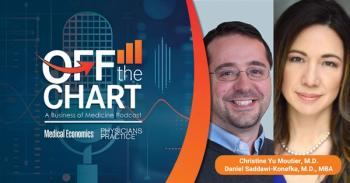
What Practices Should Know about MIPS
The Merit-Based Incentive Payment System is coming and that means physicians will be reimbursed on a different set of rules. Here's what we know so far.
Although physician practices are glad to be rid of the dreaded SGR (Sustainable Growth Rate) formula, it is being replaced with a new slew of acronyms related to the shift to value-based payment, including MACRA (Medicare Access and CHIP Reauthorization Act) and MIPS (Merit-Based Incentive Payment System).
Starting in 2017, MIPS will combine several existing programs, including the meaningful use EHR Incentive Program, the Physician Quality Reporting System (PQRS) and the Value-Based Payment Modifier (VBM). It will measure Medicare Part B providers in four performance categories to derive a score (0 to 100) that could affect a provider's Medicare reimbursement positively or negatively starting at 4 percent in 2019 and gradually increasing to 9 percent by 2022. Consumers will have access to the scores on the Physician Compare website.
Perhaps the most alarming thing about the MIPS program is how little awareness there is about it. "A lot of people may not be aware that the MACRA legislation passed last year," says Jennifer Gasperini, director of health policy for the North Carolina Medical Society. "The majority of our members are just now waking up to the fact that the world around them is changing. We would recommend they do some work to get ready now. The longer you wait, the harder it is going to be. Get familiar with existing quality programs and understand the timelines for this new structure that has been set up through MACRA."
As Arien Malec, co-chair of the federal Health IT Standards Committee, noted on Twitter recently: "It's 2016. Measurement year for MACRA/MIPS is 2017. And yet not a [healthcare executive] I've talked to has any clue what the implications are."
So what is MIPS and what are its implications? The four performance categories that will make up a provider's MIPS score are: meaningful use (25 points), VBM quality based upon PQRS measures (up to 30 points), VBM cost or resource use performance (30 points), and a new category called "clinical practice improvement" (15 points). To fill identified gaps in performance measurement, CMS is seeking to promote harmonization in the selection of measures and in the creation of new measures.
In 2017 and 2018 performance years, the program is open to physicians, physician assistants, nurse practitioners, clinical nurse specialists, and nurse anesthetists. In 2019, physical or occupational therapists, speech-language pathologists, audiologists, nurse midwives, clinical social workers, clinical psychologists, and dietitians or nutrition professionals will be eligible.
The MIPS final rule, expected in July or August, will determine how points are earned within each component and provide other details. CMS is working under a very tight timeline to get the program off the ground by next January.
Physicians Practice turned to some experts in the field to help understand the implications of MIPS on this year's activities, some ways providers are trying to influence CMS on the final rule, and some potential unintended consequences of the changes.
2016 - A REHEARSAL YEAR
In a December webinar presentation, Tom Lee, founder and CEO of Chicago-based consulting firm SA Ignite, said that practices should see 2016 as a rehearsal year for MIPS. You can make progress by redoubling efforts on some things you are already working on, he stressed. A majority of the MIPS points are related to meaningful use, PQRS, and VBM, he noted. "Consistently look for opportunities to develop and implement best practices across these three programs and to reorganize teams and processes within these three to prepare for merging them under MIPS," Lee suggested.
In the new category of clinical practice improvement, which makes up 15 points, CMS is looking for evidence of population health management and care coordination improvement. Lee said provider groups must decide if they want to apply for participation in accountable care organizations (ACO). ACO providers will eventually be exempt from MIPS. For providers who do not have enough billings to go through an ACO and fall back into MIPS, they will be guaranteed 7.5 out of the 15 points just due to membership in the ACO. Also, if you are a Patient-Centered Medical Home (PCMH) Level III certified by the National Committee on Quality Assurance throughout the entire 2017 performance year, then you automatically get 15 points, regardless of anything else you may or may not do. "If you want to go down the PCMH track, it can take six to nine months to get the information together and do the work flow changes to complete an application," he said.
Lee said that based on what is certain about MIPS, now is the time to do budgeting and planning. "Remember that budgeting for MIPS in terms of how you allocate resources could be quite different than for meaningful use and PQRS and VBM separately in the past," he said. On its website, SA Ignite has a MIPS financial calculator that can be used to estimate the dollar impact of the MIPS scoring system on a provider organization.
INFLUENCING FINAL RULE
Like many of its counterparts across the country, the North Carolina Medical Society has identified several concerns and made suggestions for improvements in the MIPS final rule, which is set to be finalized at some point in 2016. It is asking CMS to address problems with quality performance measurement. "We want CMS to make sure measures are relevant to a wide array of providers, and also, we'd like to see more measurement details," Gasperini explains. For example, how are they risk-adjusting a certain cost measure? Is it appropriate? What are the minimum case sizes CMS is looking for and is it giving the agency a statistically significant sample size? "Regarding some of those methodological problems they have been criticized for, we are saying we would like to see them take a good look at those and have a priority list of issues to resolve before they bake it into the new program."
In terms of provider identifiers and the concept of virtual groups, Gasperini says CMS has had problems in identifying and evaluating an individual provider, because they have a lot of options to report quality measures individually or in a group through various methods by using claims, a registry, or through their EHR. "So sometimes the water gets really muddy and causes confusion for practitioners and CMS," she says. "In this area we are saying CMS should support both individual-level and group-level identifiers so physicians can be evaluated on an individual basis or on a group basis based on what fits their needs, but also ensuring there are enough opportunities to participate in ways that make sense for that individual or practice."
In the area of clinical practice improvement, Gasperini says Congress intended to give credit to those already engaged in practice improvement activities. "We want that fact to be recognized, rather than CMS saying this is a new category and they are going to come up with a whole new set of requirements, each with its own process and administrative issues to deal with it," she explains. "Unfortunately, in the quality measure development plan CMS released in December it looks like they plan to stray from Congress' intent and set up additional criteria."
Finally, meaningful use has been a large pain point for providers. "We would like to see the focus change so it is not focused on fulfilling administrative requirements, and rather focused on using health IT to improve patient care and practice performance," Gasperini says. "For example, one thing that is unfair in our opinion is the all-or-nothing approach. A lot of improvements need to be made there before we can just move it into MIPS."
(In January, officials from CMS and the Office of the National Coordinator for Health IT strongly signaled that although meaningful use will continue to be part of MIPS, there will be significant changes to Stage 3 to focus more on outcome-based measures and toward allowing flexibility to customize health IT to individual practice needs.)
David Wofford, senior manager for ECG Management Consultants in San Diego, agrees with Gasperini and SA Ignite's Lee that practices should start planning for MIPS this year. "I would think that maximizing your performance under the existing programs is probably the best thing you can do," he says. "In the absence of real clarity, you have to go with what you know and see what you can do to maximize those things. But that is really cold comfort to a lot of physicians, who appear to be pretty anxious about this and I can't say I blame them."
MORE TO COME
The framework is defined by legislation, but the legislation gives authority to the Secretary of Health & Human Services, so there is a lot of detail that is going to have to be figured out - for instance, how CMS is going to administer the MIPS scores. "Doctors will get a score that places them somewhere along a sliding scale, but it is up to the secretary to determine how those four performance categories are boiled down to a single composite score," Wofford says. "It could be they construct a scheme whereby almost everybody gets a similar score or it could be they spread the scores out along that entire continuum, in which case they are moving a lot of dollars around and there are winners and losers. Where is CMS going to come down on that? We don't really know," he adds. "It wouldn't be a stretch to see a scenario where CMS gets a lot of pushback from the AMA and other organizations and then takes a conservative approach to implementing these incentives, where you don't have a big spread. But the risk there is that if everybody gets pretty much the same score no matter what, then you've got this huge administrative overhead just reporting the data and it loses its incentive effect. So they are going to have some hard decisions to make."
David Raths, is a freelance writer for Healthcare Informatics, Campus Technology, T.H.E Journal, Public CIO, and Physician Practice magazines.He can be reached at
This article was originally published in the April 2016 issue of Physicians Practice.
Newsletter
Optimize your practice with the Physicians Practice newsletter, offering management pearls, leadership tips, and business strategies tailored for practice administrators and physicians of any specialty.









